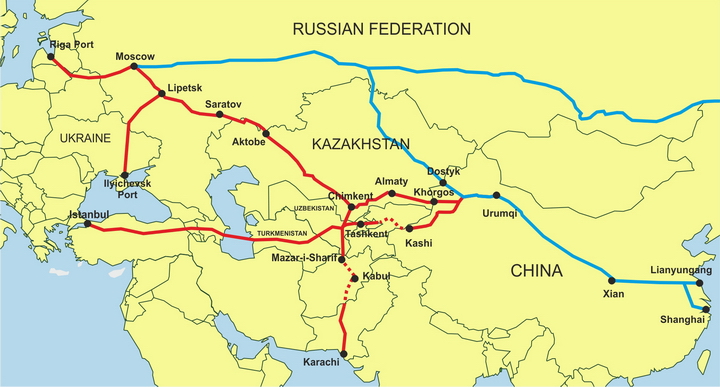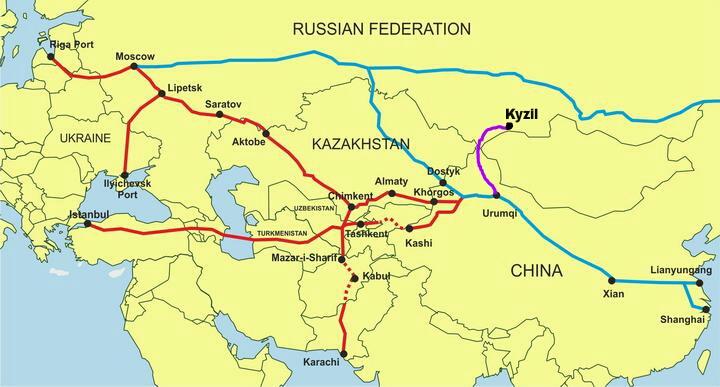Battle of Liegnitz
9 april 1241
Also known as the battle of Legnica or battle of Wahlstatt, was a collision with the aim to stop the relentless advance of the Mongol Horde. Despite the victory, this was the most advanced point reached in Europe by the Tartars, later, the political destabilization of the Mongol Empire led to the retreat of the Horde.
- Opponents
- The Mongol expansion after the death of Genghis Khan
- Decisions of the Kurultai
- The Mongol advance
- The Polish cavalry
- The opposing forces
- Deployment
- The battle
- The losses
- The consequences
LIEGNITZ
Opponents
Henry II the pious (1196/1207 ca. - April 9, 1241)
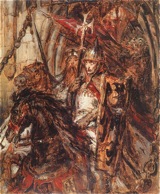
He was the son of Henry I the bearded and Hedwig of Andechs; in 1216 he married Anna, daughter of Otto I of Bohèmia. He became Duke of Krakow, Silesia and Poland in 1238.
In 1222, he supported his father in an attempt to unify Poland to fight against one of its historic enemies: Conrad I of Masovia. In the winter of 1233 until 1234, he participated in a crusade against the Prussians in the hope that his father will give him the control of Great Poland. But in June 1235, ended his campaign in a bubble so Pope Gregory IX took Henry II the pious under his protection officially appointing him successor to his father.
After the death of his father on March 19, 1238, according to papal claims, becomes, as he hoped, Duke of Krakow, Silesia and Great Poland, inheriting a vast territory which became concerned soon to maintain solid unification under its own command. To do this, tried by all means to always have on his side the land aristocracy; without them the unifying policy initiated by his father could not take place.
Against neighbouring powers, began an expansionist policy that, as early as 1239, brought its fruits with the reconquest of Lubusz and Santok lost just the previous year in favour of Brandenburg. In the same year did not miss its support to the Pope engaged in the conflict against Frederick II, but without forgetting to further expand his lands.
But here stopped the dreams of glory of Henry II.
At the end of 1239 he lost Santok again after being defeated in Lubusz, and in 1241 was killed at the battle of Liegnitz from Mongol invaders. With his death began a series of local uprisings and his dream of unification of Poland came to a screeching halt.
Despite the very short reign, in Polish iconography Henry II the pious is still recognized as an example of the Christian Knight untainted, whose brilliant feats were interrupted only by an untimely death.
In 1222, he supported his father in an attempt to unify Poland to fight against one of its historic enemies: Conrad I of Masovia. In the winter of 1233 until 1234, he participated in a crusade against the Prussians in the hope that his father will give him the control of Great Poland. But in June 1235, ended his campaign in a bubble so Pope Gregory IX took Henry II the pious under his protection officially appointing him successor to his father.
After the death of his father on March 19, 1238, according to papal claims, becomes, as he hoped, Duke of Krakow, Silesia and Great Poland, inheriting a vast territory which became concerned soon to maintain solid unification under its own command. To do this, tried by all means to always have on his side the land aristocracy; without them the unifying policy initiated by his father could not take place.
Against neighbouring powers, began an expansionist policy that, as early as 1239, brought its fruits with the reconquest of Lubusz and Santok lost just the previous year in favour of Brandenburg. In the same year did not miss its support to the Pope engaged in the conflict against Frederick II, but without forgetting to further expand his lands.
But here stopped the dreams of glory of Henry II.
At the end of 1239 he lost Santok again after being defeated in Lubusz, and in 1241 was killed at the battle of Liegnitz from Mongol invaders. With his death began a series of local uprisings and his dream of unification of Poland came to a screeching halt.
Despite the very short reign, in Polish iconography Henry II the pious is still recognized as an example of the Christian Knight untainted, whose brilliant feats were interrupted only by an untimely death.
Orda Khan (1204 - 1280)

Orda Ichen Khan was a Khan of the Mongol Empire, great General, military leader and military strategist; he was the founder of the White Horde.
Orda was the eldest son of Jochi Khan who in turn was the eldest son of Genghis Khan. He had served as a General under his large ascending and after the death of his father and grandfather before he inherited vast territories and armies to the East of the Volga. Starting from Lake Balkash, his forces formed the nascent White Horde Khanate together with his younger brother Batu Khan that inheriting the Territories West of the Volga River formed the Blue Horde Khanate during raids in Europe.
In the invasion that was planned by the Grand Khan Ögedei, Orda Khan, in 1235, led what would become the White Horde and, under him, served Baidar Khan and Kaidu Khan. His raids started in 1241 in Cracow and Lithuania, razing towns from the Baltic area to Bohemia. After the victory at Liegnitz conquests were increasingly risky and demanding a very high human cost, especially at the entrance of Hungary and Moravia for Bela IV's opposition. Then headed south into Croatia hunting to King Bela that had taken refuge in a secret fortress in Dalmatia. After plundering some cities of Croatia, arrived on the coast of present-day Albania, decided to withdraw for the deaths of Ögedei and the upcoming Kurultai that, in few years, would have been called for the succession of Batu to the great Khanate.
Orda was the eldest son of Jochi Khan who in turn was the eldest son of Genghis Khan. He had served as a General under his large ascending and after the death of his father and grandfather before he inherited vast territories and armies to the East of the Volga. Starting from Lake Balkash, his forces formed the nascent White Horde Khanate together with his younger brother Batu Khan that inheriting the Territories West of the Volga River formed the Blue Horde Khanate during raids in Europe.
In the invasion that was planned by the Grand Khan Ögedei, Orda Khan, in 1235, led what would become the White Horde and, under him, served Baidar Khan and Kaidu Khan. His raids started in 1241 in Cracow and Lithuania, razing towns from the Baltic area to Bohemia. After the victory at Liegnitz conquests were increasingly risky and demanding a very high human cost, especially at the entrance of Hungary and Moravia for Bela IV's opposition. Then headed south into Croatia hunting to King Bela that had taken refuge in a secret fortress in Dalmatia. After plundering some cities of Croatia, arrived on the coast of present-day Albania, decided to withdraw for the deaths of Ögedei and the upcoming Kurultai that, in few years, would have been called for the succession of Batu to the great Khanate.
LIEGNITZ
The Mongol expansion after the death of Genghis Khan
When Genghis Khan died in 1227, the Mongol Empire stretched from the Caspian Sea from the West, to the sea of Japan, in the East, while Kabul was the southernmost point and Siberia the further north. Only twenty years earlier, when he was elected khan of the khan, steppe nomads had coined for him the name of Chinggis, meaning "Ocean", to indicate the breadth of his domain: all kindreds between Lake Baikal and the Gobi desert were under his authority, and it was the first time that the nomadic people of Mongolia found United themselves, moreover, under a dominant nation, the Mongols one, which until then had been a less important component among many held northeastern Asia.
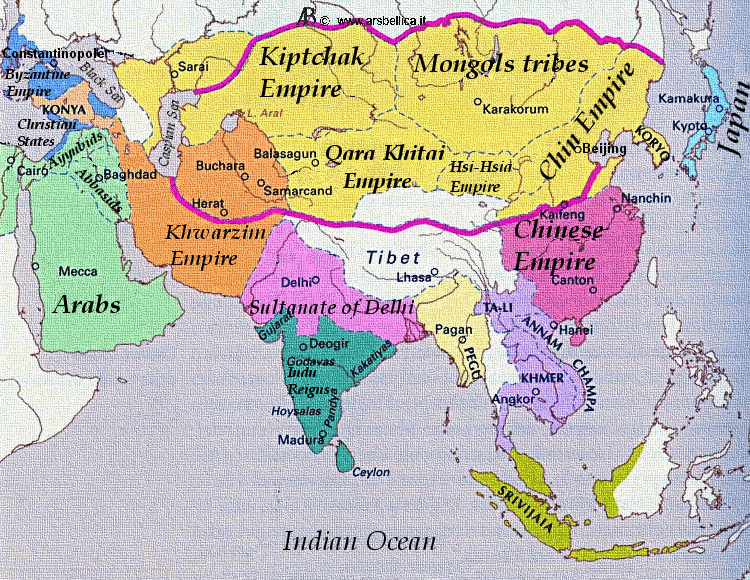
- Asia after the death of Genghis Khan (1227)
And it was just the beginning. In the two following decades, Genghis Khan would have incorporated in rapid succession the khirghisi, Uyghurs, tanguts and Tibetans, then the Golden Realm of Chin in northern China, Persian Khwarezm and Muslim kingdoms of the Iranian plateau. During his reign, his generals Subutai and Gebe went even beyond the borders of the countries included in the West: in northwestern Iran came up to Hamadan, the ancient Achaemenid capital Ecbatana, forcing the tribute to the Caliph of Baghdad; in southern Russia, seized a resounding victory over cuman Turks and Russian principles in 1223, at Kalka, and the following year on the Dnieper.
For once in history, there was no decline in the Mongol expansion after the death of its creator. Genghis Khan had plenty of time to regulate the succession and, despite the many children and grandchildren, there were no civil wars to steal strength and resources to new achievements. To inherit supreme power was the third son, Ögedei khan, while others undertook a ulus, a part of the Empire, which was then a large Confederation of States and subject to the authority of the great khan: Tolui took Mongolia, Chagatay transoxania and Kashgaria, Batu, son of Jochi, the eldest son of King died just before the father, most Western lands- the West of modern Kazakhstan. Far from unravelling, the Mongol rule, at least at this early stage, becoming consolidated, from mere aggregate of lands by raiding, to a veritable universal empire with an administration and centralization capillaries that avoided the formation of satrapies and separatism by encouraging cohesion: both in the civil and military aspects, in fact, officials and commanders serving in places very far from their countries of origin.
For once in history, there was no decline in the Mongol expansion after the death of its creator. Genghis Khan had plenty of time to regulate the succession and, despite the many children and grandchildren, there were no civil wars to steal strength and resources to new achievements. To inherit supreme power was the third son, Ögedei khan, while others undertook a ulus, a part of the Empire, which was then a large Confederation of States and subject to the authority of the great khan: Tolui took Mongolia, Chagatay transoxania and Kashgaria, Batu, son of Jochi, the eldest son of King died just before the father, most Western lands- the West of modern Kazakhstan. Far from unravelling, the Mongol rule, at least at this early stage, becoming consolidated, from mere aggregate of lands by raiding, to a veritable universal empire with an administration and centralization capillaries that avoided the formation of satrapies and separatism by encouraging cohesion: both in the civil and military aspects, in fact, officials and commanders serving in places very far from their countries of origin.
LIEGNITZ
Decisions of the Kurultai
Immediately after the final conquest of the Kingdom of Chin, left unfinished by Genghis, in 1235 there was the second most important of Kurultai Mongolian history, after the most famous, in 1206, which had elected Genghis Khan of Khan. The new gathering of chiefs was the beginning of a new, massive expansionary phase, with the offensive planning along four major lines: towards Korea, Southern Sung China, the Middle East and Eastern Europe Mamluk, piecemeal in various potentates.
In Korea, the Mongols settled in 1241, after five years of war, while in the Middle East took over within the Caucasian zone in 1239, subtracting the Georgia and Armenia to the increasingly decaying Seljuk Turks. Against Sung, however, would take more than 40 years of struggle to won. For the western offensive was encharged Batu, to whom was given the largest Mongol army ever assembled, 140,000 men divided into fourteen tumen, Mongol divisions from actual 10,000 warriors each; more than half of the forces consisted of Turks to Mongols, still under the command of Mongol officers. The three other khan collaborated to the expedition by sending each one fifth of their strength and their children as commanders of Army Corps, while the overall operational command was entrusted to the most experienced generals of Genghis Khan, Subutai, a veteran from Kalka campaign.
In Korea, the Mongols settled in 1241, after five years of war, while in the Middle East took over within the Caucasian zone in 1239, subtracting the Georgia and Armenia to the increasingly decaying Seljuk Turks. Against Sung, however, would take more than 40 years of struggle to won. For the western offensive was encharged Batu, to whom was given the largest Mongol army ever assembled, 140,000 men divided into fourteen tumen, Mongol divisions from actual 10,000 warriors each; more than half of the forces consisted of Turks to Mongols, still under the command of Mongol officers. The three other khan collaborated to the expedition by sending each one fifth of their strength and their children as commanders of Army Corps, while the overall operational command was entrusted to the most experienced generals of Genghis Khan, Subutai, a veteran from Kalka campaign.
LIEGNITZ
The Mongol advance
The operations started in 1236, with the conquest of Turkish-Muslim Kingdom of Great Bulgaria and Ukrainian territories of qipciaq and Cumans, to ward off any threat of exposing flank of the army and secure lines of communication with the East. The main body, led by Batu with Subutai, pushed it toward the goal of the campaign, Northern Russia, whose rich principalities were the most desirable prey of the area. The grandson of Gengis, moreover, found the Russian principalities weaker than the 1223 's campaign, frayed in constant internecine wars. Batu operated mainly in winter, to make quicker the advance of his cavalry by harnessing the rivers frozen, "a decision that only a Mongol could have taken," says Turnbull.
The strategic and defensive center of gravity of the area consisted of Vladimir, seat of the Grand Duke Yuri II. The Mongols there plunged after besieged and destroyed in December, Riazan, where "no eye remained open to mourn the dead," and Moscow - at that time little more than a village - while their opponent stood with the army on Sit, trusting in the strong fortifications of its capital. Vladimir ended up falling in February, 1237 after a week of siege, during which "the stones fell like water from the sky", and in the ensuing massacre found the death Grand Duke family members. At that point, Yuri thought he had nothing left to lose, "forgot fear and advanced to meet them," writes the Voskresensk Chronicle: it was pitched confrontation of Kolomna on Sit, where the Mongols were better and the Duke himslef fell in battle.
Among the most important cities, lasted only Novgorod, which the Mongols, at less than 100 kilometres from it, did not have time to reach before the spring thaw made impracticable the ground for their cavalry. The only significant event during the withdrawal to the South was the siege of seven weeks of Kozelsk in Kaluga. As was pointed out, however, the winter campaign of Batu in Russia remains the only, throughout the course of history to be turned out winning in a difficult figure for those boards.
The offensive, however, had just begun. Batu withdrew on the Don basin, where they reunited with the section headed by the son of Tolui, Mangu, which had operated between the Volga and the Don. The operations were blocked for a while, mainly due to internal dissensions related to the uncertain authority of Batu, challenged in particular by one of the sons of the great khan, Kuiuk, invoked in Mongolia.
The new attack for 1240, conducted by Mangu, had for objective the southern sector, and brought the Mongols conquest of Chernigov North of Kiev. Then it was the turn of Kiev, which fell on December 6, 1240, in front of Batu, after a siege of ten narrow tumen; the massacre was such that a chronicler, John Pian del Carpine, finding himself six years later in the ruins of what had been one of the most beautiful cities of Russia, claimed to have seen "the skulls and bones of the dead in the streets." His downfall, however, was the end to the long and prosperous Principality established three centuries earlier by Swedish Vikings, the so-called Varangians. After Batu wintered just north-east of the Carpathians, in Galicia, clearly understanding the next leaving goal of the offensive.
The strategic and defensive center of gravity of the area consisted of Vladimir, seat of the Grand Duke Yuri II. The Mongols there plunged after besieged and destroyed in December, Riazan, where "no eye remained open to mourn the dead," and Moscow - at that time little more than a village - while their opponent stood with the army on Sit, trusting in the strong fortifications of its capital. Vladimir ended up falling in February, 1237 after a week of siege, during which "the stones fell like water from the sky", and in the ensuing massacre found the death Grand Duke family members. At that point, Yuri thought he had nothing left to lose, "forgot fear and advanced to meet them," writes the Voskresensk Chronicle: it was pitched confrontation of Kolomna on Sit, where the Mongols were better and the Duke himslef fell in battle.
Among the most important cities, lasted only Novgorod, which the Mongols, at less than 100 kilometres from it, did not have time to reach before the spring thaw made impracticable the ground for their cavalry. The only significant event during the withdrawal to the South was the siege of seven weeks of Kozelsk in Kaluga. As was pointed out, however, the winter campaign of Batu in Russia remains the only, throughout the course of history to be turned out winning in a difficult figure for those boards.
The offensive, however, had just begun. Batu withdrew on the Don basin, where they reunited with the section headed by the son of Tolui, Mangu, which had operated between the Volga and the Don. The operations were blocked for a while, mainly due to internal dissensions related to the uncertain authority of Batu, challenged in particular by one of the sons of the great khan, Kuiuk, invoked in Mongolia.
The new attack for 1240, conducted by Mangu, had for objective the southern sector, and brought the Mongols conquest of Chernigov North of Kiev. Then it was the turn of Kiev, which fell on December 6, 1240, in front of Batu, after a siege of ten narrow tumen; the massacre was such that a chronicler, John Pian del Carpine, finding himself six years later in the ruins of what had been one of the most beautiful cities of Russia, claimed to have seen "the skulls and bones of the dead in the streets." His downfall, however, was the end to the long and prosperous Principality established three centuries earlier by Swedish Vikings, the so-called Varangians. After Batu wintered just north-east of the Carpathians, in Galicia, clearly understanding the next leaving goal of the offensive.
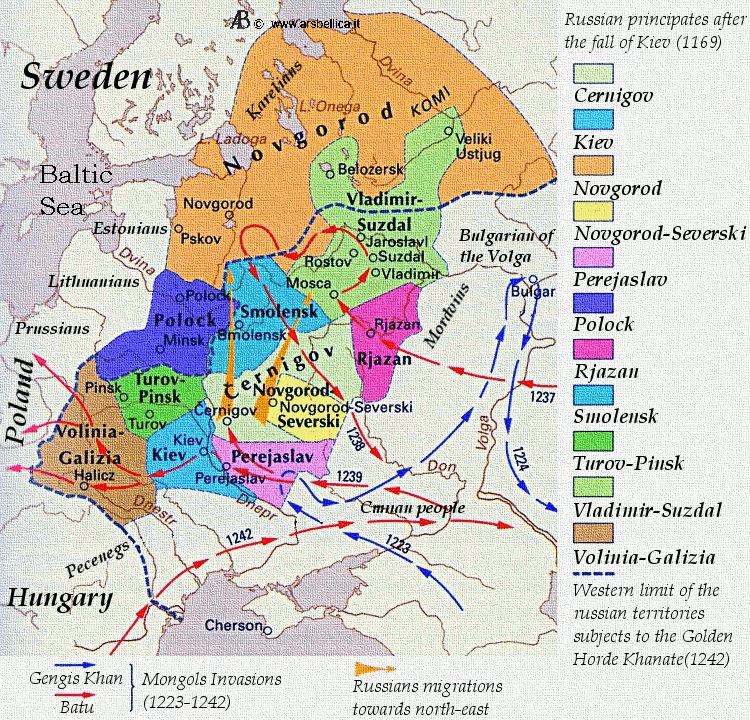
- Fall of Kiev and Mongol invasion (1169 - 1242)
The Hungary, in fact, was very close. And Hungary had always been, in the past, the limit of the Western conquests of nomadic Empires, from the Huns to the Magyars, but also the advanced base from which launch into further conquests in Central Europe. It seemed so natural the road along which the Mongols would continue to act, especially since their invasion caused a wave of refugees in Poland but above all in Hungary itself: it was rumored that the cuman khan Kotyan had brought 200,000 souls behind, which the Mongols believed their subjects. The King Bela IV had welcomed not only the Russian Princes who had not accepted Mongol suzerainty, but also the nomadic people on the run, behind the effort to convert to Christianity. In addition, the country was then weakened by a dispute with the Papacy, and did not seem able to deal with the invaders.
Europe was panicked. The Mongols seemed invincible, with their extraordinary speed, which made them appear suddenly and unexpectedly on a area, siege skills, inedited in all nomadic peoples, learned from the Chinese and that exploited to conquer all who submitted to siege, efficient military structure, which equalled to rout any enemy dared to face them in a pitched battle. As if that weren't enough, Westerners were unaware of what was the true strength of the Mongols: the careful planning of the campaigns and strategic vision, inherited from Genghis Khan, the unequaled in the world.
The hospitality granted to Kotyan offered to Batu the pretext to invade the country. The passage of the Carpathians from the main army, led by Batu was expected, of course, for the winter, from european point of view, and had as its objective the capture of Pest; the second section of the army, entrusted to Kaidu Ögedei's son and the son of Baidar Chagatay, had the task of protecting the right flank, with rampaging in Poland just as surprising for opponents, who were not expecting to see appear an army on the frozen Vistula. Another detachment had to act further north, in Lithuania and East Prussia. The Mongols quickly came on Sandomierz, and even the surrounding monasteries escaped with their loot. The invaders get so many prisoners that, in order not to jeopardize their proverbial quickly, felt compelled to return to the border to get rid of them and then shipped again in their advance.
The withdrawal gave to the voivode of Kraków, who was acting on behalf of Prince Boleslaw V the chaste, a chance to gather a small army, led by heavy cavalry, surprising enemies Czarda River; once rallied by this surprise, the Mongols realized to be in front of a contingent of little relevance, and counterattacked, taking advantage also of the fact that the enemies Knights had scattered in search of loot. At the end of the day the victory was for the Tatars, so they could continue undisturbed to the Vistula River.
They had suffered casualties in the clash, or deem necessary to thickening ranks, however the Mongols returned to Poland with a larger army. While the invaders reached back Sandomierz, the Poles stopped at Chmielnick on the road to Kraków, where it continued to reside the Prince. The Mongols attacked the post at dawn on March 18, 1241, ushering in a fierce battle that lasted for several hours, until the actual number did not weigh the balance in favor of the Tartars. Not being able to throw into the fray fresh forces that had to replaced the first line exhausted from the long fighting, the Poles ended up fleeing: "Some reached the coverage offered by the forests and, knowing the terrain, escaped; but the majority found a glorious death defending their country and their faith, "writes Dlugosz.
The way to Krakow was open to the Mongols, who entered on Palm Sunday, March 24, without found not only strength, but no living soul. The Prince and his family had left it to Hungary, while the inhabitants were hidden in the swamps and forests; Anyway, as to don't lose their reputation, the Tatars the reduced it to ashes. Not found anything that might oppose a further advance in the West, where he headed a section of the army, Mongols did not loot and preside over the Polish lands. The next barrier was represented by the Oder, beyond which is entered in a straight line by Archduke Henry II the pious. The Mongols crossed the river en masse at the height of Ratibor, on rafts and swimming, "as the Tartars are more experienced in the art of swimming of any other nation", focusing on Wroclaw.
The vanguard was surprised by a contingent of Duke Mieczyslaw, but then the arrival of the bulk of the Mongol forces forced Christians to fold and reach Henry. The latter, for its part, had abandoned its capital Wroclaw in order to set up a coalition of most important political entities of the area who had reason to fear the Mongol invasion. He not only joined the Silesian troops but also those of Poland and Moravia, as well as the Teutonic Knights. To give numerical consistency to his army, Duke recruited peasants miners came from the gold mines of the region. Then to Legnica, Liegnitz, waited for the junction with the forces led by Wenceslaus of Bohemia, which was carrying other 50,000 men.
As in Krakow, the Mongols found Breslau not only without inhabitants, but also without whatever could supply them; the residents, in fact, had burned the entire city and who had not escaped was being defended in the Citadel. The chance to attack the latter was discarded once learned of the dam operated by Henry just West. He hoped to see appear Wenceslaus, or reach him, before the arrival of the Mongols, however could not do anything but stay on the field when the Mongol army commanders assembled their pieces.
Europe was panicked. The Mongols seemed invincible, with their extraordinary speed, which made them appear suddenly and unexpectedly on a area, siege skills, inedited in all nomadic peoples, learned from the Chinese and that exploited to conquer all who submitted to siege, efficient military structure, which equalled to rout any enemy dared to face them in a pitched battle. As if that weren't enough, Westerners were unaware of what was the true strength of the Mongols: the careful planning of the campaigns and strategic vision, inherited from Genghis Khan, the unequaled in the world.
The hospitality granted to Kotyan offered to Batu the pretext to invade the country. The passage of the Carpathians from the main army, led by Batu was expected, of course, for the winter, from european point of view, and had as its objective the capture of Pest; the second section of the army, entrusted to Kaidu Ögedei's son and the son of Baidar Chagatay, had the task of protecting the right flank, with rampaging in Poland just as surprising for opponents, who were not expecting to see appear an army on the frozen Vistula. Another detachment had to act further north, in Lithuania and East Prussia. The Mongols quickly came on Sandomierz, and even the surrounding monasteries escaped with their loot. The invaders get so many prisoners that, in order not to jeopardize their proverbial quickly, felt compelled to return to the border to get rid of them and then shipped again in their advance.
The withdrawal gave to the voivode of Kraków, who was acting on behalf of Prince Boleslaw V the chaste, a chance to gather a small army, led by heavy cavalry, surprising enemies Czarda River; once rallied by this surprise, the Mongols realized to be in front of a contingent of little relevance, and counterattacked, taking advantage also of the fact that the enemies Knights had scattered in search of loot. At the end of the day the victory was for the Tatars, so they could continue undisturbed to the Vistula River.
They had suffered casualties in the clash, or deem necessary to thickening ranks, however the Mongols returned to Poland with a larger army. While the invaders reached back Sandomierz, the Poles stopped at Chmielnick on the road to Kraków, where it continued to reside the Prince. The Mongols attacked the post at dawn on March 18, 1241, ushering in a fierce battle that lasted for several hours, until the actual number did not weigh the balance in favor of the Tartars. Not being able to throw into the fray fresh forces that had to replaced the first line exhausted from the long fighting, the Poles ended up fleeing: "Some reached the coverage offered by the forests and, knowing the terrain, escaped; but the majority found a glorious death defending their country and their faith, "writes Dlugosz.
The way to Krakow was open to the Mongols, who entered on Palm Sunday, March 24, without found not only strength, but no living soul. The Prince and his family had left it to Hungary, while the inhabitants were hidden in the swamps and forests; Anyway, as to don't lose their reputation, the Tatars the reduced it to ashes. Not found anything that might oppose a further advance in the West, where he headed a section of the army, Mongols did not loot and preside over the Polish lands. The next barrier was represented by the Oder, beyond which is entered in a straight line by Archduke Henry II the pious. The Mongols crossed the river en masse at the height of Ratibor, on rafts and swimming, "as the Tartars are more experienced in the art of swimming of any other nation", focusing on Wroclaw.
The vanguard was surprised by a contingent of Duke Mieczyslaw, but then the arrival of the bulk of the Mongol forces forced Christians to fold and reach Henry. The latter, for its part, had abandoned its capital Wroclaw in order to set up a coalition of most important political entities of the area who had reason to fear the Mongol invasion. He not only joined the Silesian troops but also those of Poland and Moravia, as well as the Teutonic Knights. To give numerical consistency to his army, Duke recruited peasants miners came from the gold mines of the region. Then to Legnica, Liegnitz, waited for the junction with the forces led by Wenceslaus of Bohemia, which was carrying other 50,000 men.
As in Krakow, the Mongols found Breslau not only without inhabitants, but also without whatever could supply them; the residents, in fact, had burned the entire city and who had not escaped was being defended in the Citadel. The chance to attack the latter was discarded once learned of the dam operated by Henry just West. He hoped to see appear Wenceslaus, or reach him, before the arrival of the Mongols, however could not do anything but stay on the field when the Mongol army commanders assembled their pieces.
LIEGNITZ
The Polish cavalry
It is known as the base of the European Knight weapons were sword and spear. But in addition to these, the arsenal included a series of small weapons such as daggers, axes, hammers, spades and many others. The Polish cavalry did not differ too much in this equipment from those of the rest of Europe, and the sword that was commonly used was not different from the swords used in the West: it was straight, with a blade of 80-120 cm long and 1.0-1,8 kg in weight. Even the spear, was 3.5-4.5 meter long, with angular shaped tip, and counterweight close to the terminal part.
The defensive armament - the armour - included, at first the gambeson, then became brigandine and scale armour, followed by hauberk, and then mail with some metal elements to the end of the 16th century, when it gained its "perfect" shape, protecting the entire body of a Knight, and sometimes his horse.
On the eve of the battle with the Mongols, the process of evolution of the cavalry in Poland, does not undergo significant changes and developments. In order to recreate the image of the army of those times, it is essential to know the functions of particular classes of society, military service, works specific to the needs of the army and in-kind services for the aforementioned military service. The first type of service rested primarily in the hands of soldiers (nobles as in the rest of Europe) while the other two were the responsibility of burghers and (most) of the peasants. This period is little studied by historical research, but the battle of Liegnitz is so rich in iconography that we can try to make some estimates. The armor of a soldier had changed very little, but eminent Knights (as well as Henry II the pious), had their hauberk enriched with elements made of sheet iron, large and well decorated helmets. Leszek Czarny, just to take another example, died in 1288, is depicted on his gravestone in Kraków in full plate armour.
Polish tactics on the battlefield were not so complicated. The Knights (along with their Squires) stayed in closed formation with infantry on the flanks, and, after the initial shot by archers and Crossbowmen, began charging. In the moment when the Commander - that fought at the head of the main detachment - was losing control over his cavalry unit and battle fell in a Scrum and in disorder, the possibility of panic was the crucial element of the fight, and the battle, apparently won after the first charge, could be lost.
The defeat of Liegnitz enriched the Polish cavalry's strategic horizon, which, however, had gone with managed to understand the importance of mobility in their battle formations on horseback, tried not to deviate too much from the ever chivalrous tendencies of Western Europe, attempting a tactical mix, still not entirely investigated properly by historians.
The defensive armament - the armour - included, at first the gambeson, then became brigandine and scale armour, followed by hauberk, and then mail with some metal elements to the end of the 16th century, when it gained its "perfect" shape, protecting the entire body of a Knight, and sometimes his horse.
On the eve of the battle with the Mongols, the process of evolution of the cavalry in Poland, does not undergo significant changes and developments. In order to recreate the image of the army of those times, it is essential to know the functions of particular classes of society, military service, works specific to the needs of the army and in-kind services for the aforementioned military service. The first type of service rested primarily in the hands of soldiers (nobles as in the rest of Europe) while the other two were the responsibility of burghers and (most) of the peasants. This period is little studied by historical research, but the battle of Liegnitz is so rich in iconography that we can try to make some estimates. The armor of a soldier had changed very little, but eminent Knights (as well as Henry II the pious), had their hauberk enriched with elements made of sheet iron, large and well decorated helmets. Leszek Czarny, just to take another example, died in 1288, is depicted on his gravestone in Kraków in full plate armour.
Polish tactics on the battlefield were not so complicated. The Knights (along with their Squires) stayed in closed formation with infantry on the flanks, and, after the initial shot by archers and Crossbowmen, began charging. In the moment when the Commander - that fought at the head of the main detachment - was losing control over his cavalry unit and battle fell in a Scrum and in disorder, the possibility of panic was the crucial element of the fight, and the battle, apparently won after the first charge, could be lost.
The defeat of Liegnitz enriched the Polish cavalry's strategic horizon, which, however, had gone with managed to understand the importance of mobility in their battle formations on horseback, tried not to deviate too much from the ever chivalrous tendencies of Western Europe, attempting a tactical mix, still not entirely investigated properly by historians.
LIEGNITZ
The opposing forces
Contemporary chroniclers claim that "there were many Tatar units, each of which, by itself, was superior in number of the entire Polish Army". But in reality, the Mongols were outnumbered, and it was probable that if Wenceslas arrived they would have had no chance. The same Dlugosz, moreover, writes that Orda deployed his army on four lines. Although it has arrived to give to Henry even 40,000 men, it is believed that his army was up to 10,000, a number that did not give any guarantee in front of tumen enemy, especially on one plaain, such as the area unexpectedly chosen by Prince, who favored so glaring Mongol Cavalry dynamics.
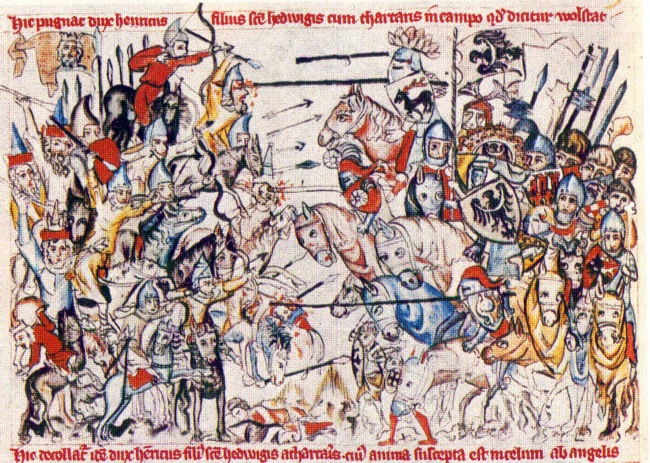
- The battle of Liegnitz in a 15th century miniature
That the poles were more numerous, prove the fact that they were to inaugurate the battle, with a charge of the first line that would not have dared to do, if you were found in inferiority. According to a chronicle of a Franciscan friar, found in the sixties of the twentieth century, the army under Orda orders not exceeded a tumen - just 10,000 men.
LIEGNITZ
Deployment
On 9 April the Archduke came to Liegnitz accompanied by a bleak omen, as a stone was moved from a church almost strike him. He moved towards the city and sided Wahlstatt ragtag army, by deploying it, according to Dluglosz, on five consecutive lines along flat ground near the River Nysa. In the front row poses the fighters from Germany and other parts of Europe, supported by some departments of farmers-miners. The two subsequent lines were formed by Polish Knights, respectively of Krakow and Opole, followed by the Teutonic Knights, while Henry reserve placed himself and his Silesian Knights, besides a modest contingent of mercenaries. But as the presence of the Teutonic order is uncertain, we must consider the possibility that the lines were only four.
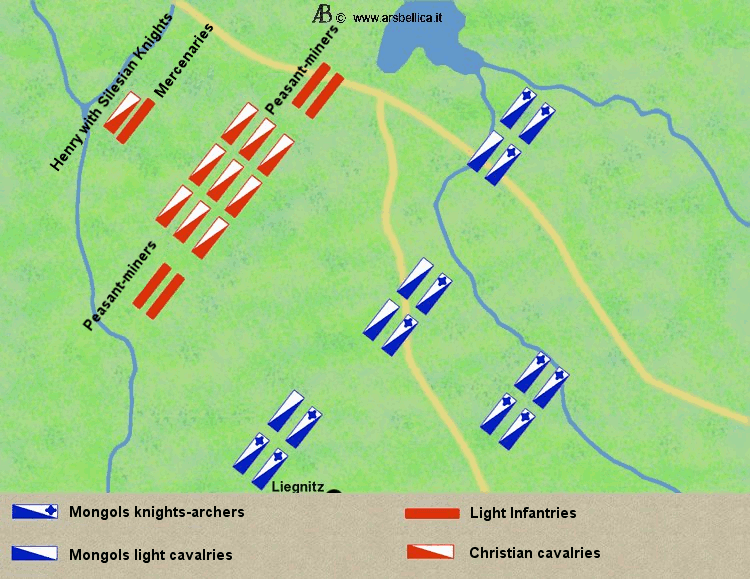
- The battle of Liegnitz - Deployment
The Mongols, for their part, chosen a "T" formation in which the distances between the various departments of mixed light cavalry and archers cavalries were large in such a way as to allow the surrounding manoeuvres, typical of their fighting style.
LIEGNITZ
The battle
The first Mongol left line charge first against Polish chivalries, as mentioned above, by pulling until non-Christians found themselves surrounded by enemy archers and isolated from the rest of the deployment. As for the vast majority of combatants without armor, all fell under a hail of arrows, "as the delicate ears of corn broken by hailstones", except for some who had had time to break away.
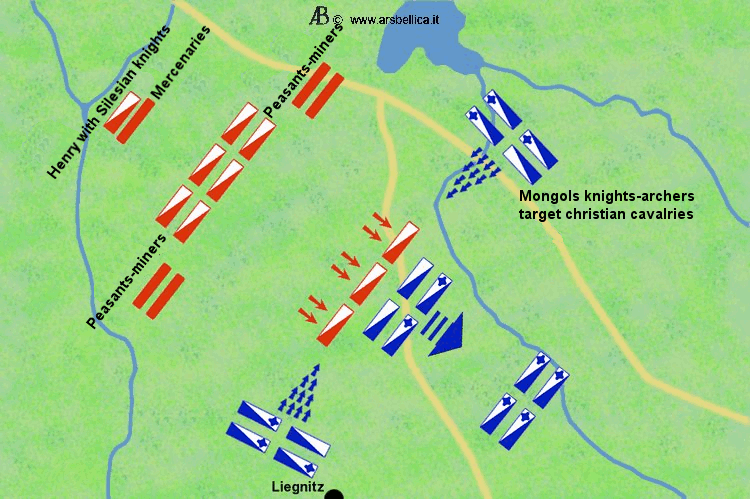
- The battle of Liegnitz - First charge
Henry hastened to send forward two other lines, as did Orda, but still had the warriors of the first line. However, the Crossbowmen under cover from the army of Henry proved more effective than Mongol archers and Christians seem to hold. In the long run, though, began to lose ground, and Henry felt compelled to let his forces into battle best, whether it was Teutonic or Polish reserve, we do not know. Once the Mongol Commander imitated him dragging behind his fourth formation, and a brawl start again.
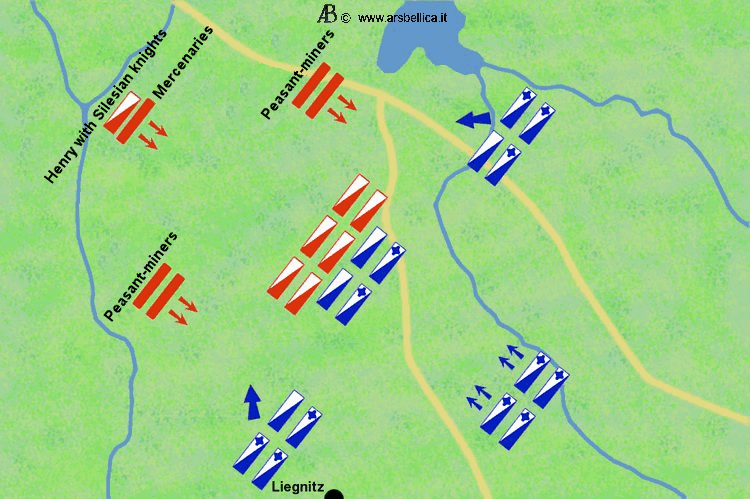
- The battle of Liegnitz - Other forces come into battle
Spent more time, were the Mongols to withdraw and, when they were at some distance from the enemy, their signifer waved the banner, marked by crossed bones of sheep and yak tails. It was the signal agreed to enable men to set fire to the reeds, from which rose a dense smoke and a smell unbearable for Christians. This was a surprie for poles: "we knew that in their wars the Tartars have always resorted to the arts of divination and witchcraft, and is precisely what they were doing at that time," writes dismay Dlugosz.
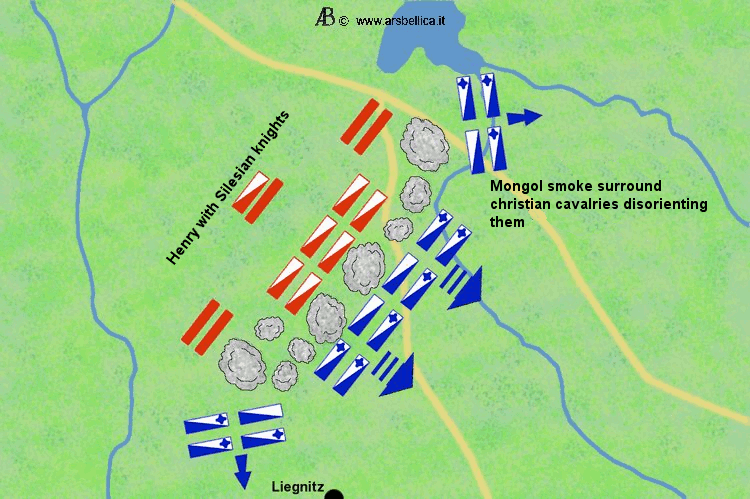
- The battle of Liegnitz - Mongols shelter behind a dense smoke
Christians, confused, lost any remaining boldness and moved outflanked in that cloud of smoke. When they not even realized what happened, the Mongols returned on their steps and suddenly began to come out from the thick artificial fog, herald only from their war cry. The light cavalry attacked the poles on the sides with many of arrows, while the center pushed them again: "a huge massacre ensued". Fell, among others, the Margrave of Moravia and the Regional Commander of the Teutonic Knights, all opposition was gone and Henry, which could have been fleeing with his host, chose to wait until he had been invested.
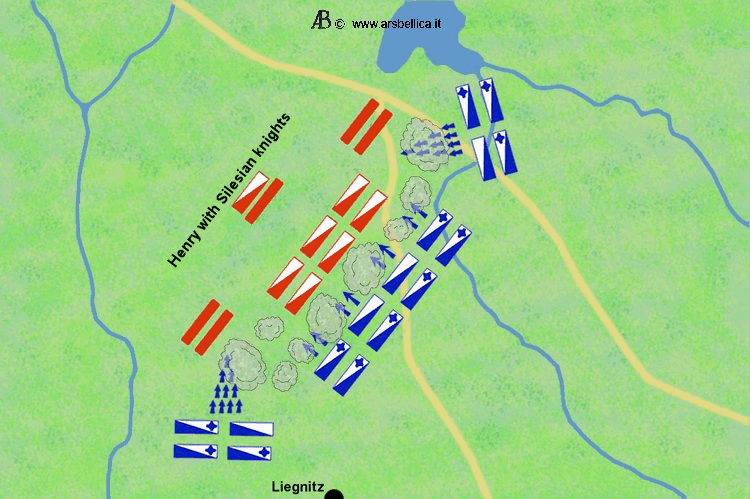
- The battle of Liegnitz - Mongols Attacks through smoke
In short he was attacked from all sides. At that point, the Archduke tried to open a way to escape from the fighting, along with a handful of followers. He stuck in enemy lines, but as advancing, his own warriors fell, and the gap remained with only four men, too few to prevent his horse, already wounded, was finished by enemy blows. One of his knights rushed to give him another horse, but now the Mongols had recognized the Prince from his signs, and closed all gates.
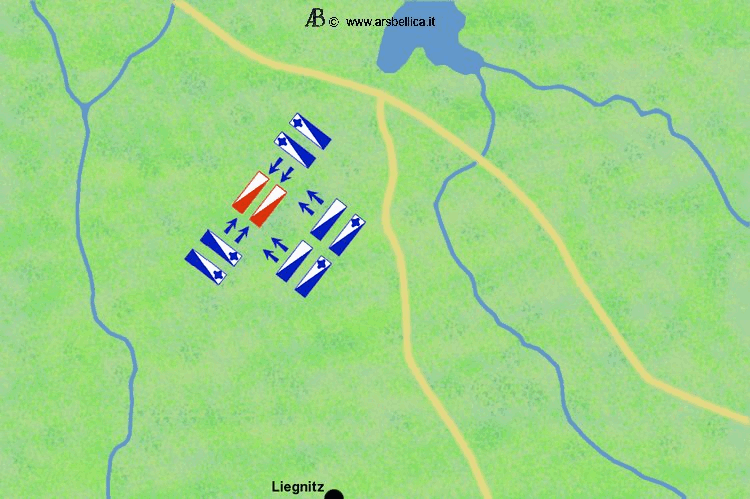
- The battle of Liegnitz - The end of Henry
A tartare spear penetrated Henry in the armpit, not protected by armor, while Archduke rose his arm to drop a blow on the nearest opponent. The Prince fell to the ground, and immediately the Mongols took him around, right through him with two arrows; then dragged him away from his warriors and cut off her head, stripping the body of its insignia and leaving him naked on the ground.
His head was stuck on a pole and displayed in front of the walls of Legnica to induce the defenders to open the doors, but they refused to do. They chose instead of reestablishing themselves in the stronghold after burned the city, preventing the Mongols, who feared to reach Wenceslas's army, threaten over them. It seems instead that the Knight who had offered to Archduke the horse, saved his own life, and later gone in a Dominican monastery, "grateful the Lord saved him from many dangers".
His head was stuck on a pole and displayed in front of the walls of Legnica to induce the defenders to open the doors, but they refused to do. They chose instead of reestablishing themselves in the stronghold after burned the city, preventing the Mongols, who feared to reach Wenceslas's army, threaten over them. It seems instead that the Knight who had offered to Archduke the horse, saved his own life, and later gone in a Dominican monastery, "grateful the Lord saved him from many dangers".
LIEGNITZ
The losses
On the field, with Henry, lay much of the Polish nobility. It was said that the Mongols, wanting to know the exact number of fallen foes, have cut one ear to each of the corpses "by filling to the brim nine huge sacks".
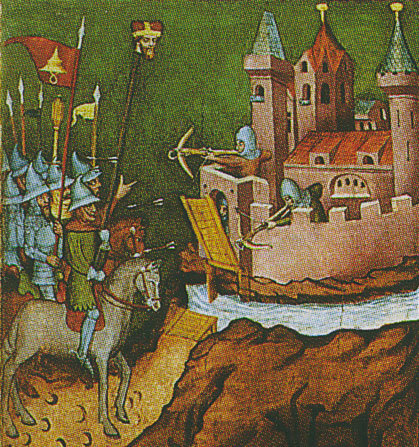
- The Mongols exhibit the head of Henry II in front of the walls of Legnica to induce the defenders to open the doors
The Poles found it hard to find the headless body of the Archduke, at least until the widow reported that her husband had six fingers in the left foot.
LIEGNITZ
The consequences
In the area, the Mongols not pushed further, deviating towards Moravia to rejoin Batu. The main objective of the advance westward remained the Hungary, and at the time the latter had meanwhile moved the main army, on the Vistula river near Halicz. In his march toward Pest, Batu had divided his army into four parts, two extreme wings to the North and South, and two other central sections, respectively through Galicia, Moldavia and Transylvania. Gathered near the capital, the Tatars were approached by the relief army staged by Bela, but it captured to the collision by a retreat to the East. Nine days later, and, according to tradition, two days after the battle of Liegnitz, near the village of Mohi Hungarians were surprised in his sleep by a pincer movement. Was a massacre, from which he barely escaped the King himself. Pest, of course, made a bad end, and for the rest of the year the Hungarians came to feed the Mongol armies, before they would resume their advance westward, with Vienna as the next goal.
During the break that took the Mongols, Bela was unable, despite his efforts, to bring Christianity to enact a crusade to block the danger represented by the invaders. The Pope was too busy in his quarrels with the emperor to take into cosideration to hold a crusade in an area that wasn't the italic one, where he saw the real enemy of the faith in the emperor Frederick II. The appeal said only the Teutonic Knights, but preferred to choose an enemy theoretically more malleable and more compatible with their interests in the Baltic region-Novgorod, Russia; eventually they fixed a memorable defeat at the battle of Lake Peipus at the hands of Prince Nevsky.
After being joined by Kaidu, Batu only expectations that winter was the freezes of the Danube in order to resume the campaign. Khan arrived in Zagreb and destroy almost anything on the shores of the Adriatic Sea, near Split, in an effort to reach the Hungarian King, while his right wing is pushing in the direction of Vienna. But in February 1242 news came of the death of the great khan Ögedei died in previous December, a fact that opened the question of succession. Batu was required to attend the Kurultai, and had no choice but to abandon any ambitions back on Europe.
His ambitions, however, were frustrated by the election of Guyuk, to whom Batu never gave homage, preferring to return to administer autonomous domain Western Territories, which now included the Russian principalities, whose capital was at Sarai on the Volga. Mongolian State was, as it was called by Europeans, the Golden Horde, as was defined for the golden curtain of Batu. Besides Russian territories, it embraced a large area corresponding to the present-day Kazakhstan, becoming progressively in Turkish and Islamic State. Well again administrated for a century, it had suffer only a return of Muscovy and, especially, the aggression of Tamerlane; in the progress of time, ended up split into various Hordes, often at war with each other, and lost his control over the Russian territories, which ended up becoming independent. At the dawn of the modern age, Ivan IV the terrible gave the final blow to the great Horde and Crimean Tatars remained the only, from which the Mongols took a small revenge recapturing the capital Moscow temporarily in 1571, the Crimean Khanate survived until the 18th century, to be eventually incorporated into Ottoman Empire.
During the break that took the Mongols, Bela was unable, despite his efforts, to bring Christianity to enact a crusade to block the danger represented by the invaders. The Pope was too busy in his quarrels with the emperor to take into cosideration to hold a crusade in an area that wasn't the italic one, where he saw the real enemy of the faith in the emperor Frederick II. The appeal said only the Teutonic Knights, but preferred to choose an enemy theoretically more malleable and more compatible with their interests in the Baltic region-Novgorod, Russia; eventually they fixed a memorable defeat at the battle of Lake Peipus at the hands of Prince Nevsky.
After being joined by Kaidu, Batu only expectations that winter was the freezes of the Danube in order to resume the campaign. Khan arrived in Zagreb and destroy almost anything on the shores of the Adriatic Sea, near Split, in an effort to reach the Hungarian King, while his right wing is pushing in the direction of Vienna. But in February 1242 news came of the death of the great khan Ögedei died in previous December, a fact that opened the question of succession. Batu was required to attend the Kurultai, and had no choice but to abandon any ambitions back on Europe.
His ambitions, however, were frustrated by the election of Guyuk, to whom Batu never gave homage, preferring to return to administer autonomous domain Western Territories, which now included the Russian principalities, whose capital was at Sarai on the Volga. Mongolian State was, as it was called by Europeans, the Golden Horde, as was defined for the golden curtain of Batu. Besides Russian territories, it embraced a large area corresponding to the present-day Kazakhstan, becoming progressively in Turkish and Islamic State. Well again administrated for a century, it had suffer only a return of Muscovy and, especially, the aggression of Tamerlane; in the progress of time, ended up split into various Hordes, often at war with each other, and lost his control over the Russian territories, which ended up becoming independent. At the dawn of the modern age, Ivan IV the terrible gave the final blow to the great Horde and Crimean Tatars remained the only, from which the Mongols took a small revenge recapturing the capital Moscow temporarily in 1571, the Crimean Khanate survived until the 18th century, to be eventually incorporated into Ottoman Empire.

































